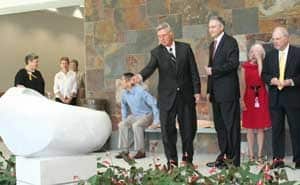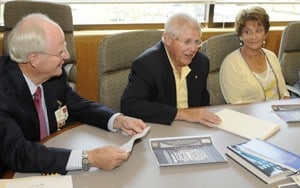2010 Highlights Include Cancer Institute Expansion
Dec. 28, 2010 | A 12-story expansion to the Winthrop P. Rockefeller Cancer Institute that opened in July at the University of Arkansas for Medical Sciences (UAMS) highlighted a year that continued the UAMS commitment to improve health in Arkansas. The 300,000-square-foot, $130 million building dedicated July 31 doubled the institute’s capacity for research, treatment and outreach. Its design — which included an abundance of natural light, balconies and a healing garden — promoted a comfortable environment for patients, while also promoting collaboration between clinicians and researchers. The expansion seamlessly connected to the institute’s Pat and Willard Walker Tower, which opened in 1989. With more than 120,000 patient visits annually, the Cancer Institute attracts patients from every county in Arkansas, all 50 states and more than 40 foreign countries. The Cancer Institute dedication was one of the stories in 2010 that illustrated the UAMS missions of patient care, education and research in the service of the institution’s commitment to the state. “This has been a year where our institution’s mission of health care improvement was reflected in new facilities, new technology, new programs and a lot of hard work,” said UAMS Chancellor Dan Rahn, M.D. Construction continues at the Cancer Institute as the first floor of the Walker Tower is renovated to include a food court, patient support pavilion, chapel, gift shop and other services. The renovation is scheduled for completion in mid-2011. Also planned for completion in 2011 are two research floors funded by a nearly $10.5 million grant from the National Center for Research Resources (NCRR), a division of the National Institutes of Health (NIH), announced in January 2010. In addition, another floor of the Institute will be finished thanks to a bond issue approved by the University of Arkansas Board of Trustees in November. That same bond issue also included funds to finish the 9th floor of the UAMS Medical Center hospital expansion that opened in 2009. That work, expected to start in 2011, will provide 30 much-needed new adult inpatient beds for the hospital. Also in 2010, UAMS received more than $102 million in stimulus money to establish or upgrade broadband connections at 474 health care and education sites across Arkansas. The federal grant – one of the largest ever received by an Arkansas institution – was announced in August. “Arkansas is about to have one of the most connected health care systems in the nation,” said Rick Wade, senior advisor and deputy chief of staff at the U.S. Department of Commerce, in announcing the grant. “This grant represents an investment that will pay dividends for generations, but there’s no dollar figure for the lives saved, the new educational opportunities and the overall quality-of-life benefits this will bring to the people of Arkansas.” The new connectivity will enable medical specialists to provide care to rural areas using two-way interactive video (telemedicine). The completed network has the potential for expansion to 3,926 additional community institutions. Those include 1,072 K-12 public schools, 29 charter schools, 305 private schools, 412 long-term care facilities, 758 provider clinics, 231 public libraries, 203 licensed ambulance services, 264 police departments, 575 fire departments and 77 offices of emergency management. Another way UAMS resources will be extended across the state is through the new statewide trauma network. The UAMS trauma program in September became the first in the state to achieve Level I designation from the Arkansas Department of Health as providing the highest level of trauma care. UAMS received the designation following an August survey by the state health department, which is administering the new statewide trauma system. At the top of the system for coordinating emergency care in the state, Level I trauma centers must have specialized surgeons on duty at all times to quickly care for the most serious and urgent cases. Level I centers also must include education, preventive and outreach programs as well as a program of trauma research. “The Level I designation reflects hard work by our trauma program and hospital to be a catalyst for improving trauma care in Arkansas,” said Richard Pierson, UAMS vice chancellor for clinical programs and UAMS Medical Center executive director. Among the past year’s many achievements, highlighted in each UAMS mission: Patient Care • UAMS introduced a new online patient portal in April. The free and secure MyUAMSHealth portal allows patients to view and pay their bill, schedule a doctor’s appointment, refill a prescription and view lab results. • In May, Leland and Betty Tollett of Rogers pledged $3 million to the Harvey & Bernice Jones Eye Institute at the University of Arkansas for Medical Sciences (UAMS) to establish the Leland and Betty Tollett Retinal and Ocular Genetics Center. The Tolletts’ gift will provide the resources to finish out the eighth floor of the Jones Eye Institute to house the center, which will include diagnostic and treatment space, low vision and rehabilitation space, clinical research and database facilities. Basic research will continue on the third floor and will be expanded to include basic genetic research. • The UAMS Center for Rural Health opened in May, offering a clearinghouse for rural health care improvement efforts across the state. UAMS leaders said the center will become a primary outreach arm, working closely with public and private programs to improve the health of rural Arkansans. The center was created in conjunction with the reorganization of UAMS Regional Programs and the UAMS Rural Hospital Program. The Regional Programs umbrella includes the new center and the eight Area Health Education Centers (AHECs). The AHECs are located throughout the state to provide residency training to family medicine physicians, clinical services and education in other health care fields. • A five-year grant worth $2.7 million to improve mental health care in community health centers throughout Arkansas was awarded to John Fortney, Ph.D., and Geoffrey Curran, Ph.D., both of UAMS and Sip Mouden of the Community Health Centers of Arkansas Inc. (CHCA). Announced in September, the award will be used to develop a partnership among researchers in the UAMS Department of Psychiatry and the CHCA, which delivers primary care and other health care services to more than141,000 Arkansans living in medically underserved areas across the state. • The UAMS Center for Distance Health was designated one of four new Regional Telehealth Resource Centers in the U.S., serving Arkansas, Mississippi and Tennessee. The UAMS-based resource center will provide technical assistance and training for health care organizations, networks and providers as they develop cost-effective telehealth programs serving rural and medically underserved areas in all three states. • UAMS leaders used hammers to break ceiling tile in a November ceremony marking the start of a four-floor expansion at the Donald W. Reynolds Institute on Aging. The 55,000-square-foot expansion, on top of the existing four-story institute, is funded by a $30.4 million grant from the Donald W. Reynolds Foundation, announced in June 2009. When construction is completed in early 2012, the additional space will enable the institute to greatly expand its education, research and interdisciplinary training programs. Research • Marking a shift in decades of thought on the cause of osteoporosis, UAMS researchers identified an age-related mechanism – not a decrease of the hormone estrogen – as the primary culprit. Aging and the body’s increased inability to defend against bone-damaging molecules produced through a process known as oxidative stress are most directly responsible for the bone-weakening disease – and perhaps other age-related diseases, reported researchers led by Stavros Manolagas, M.D., Ph.D., in the UAMS Center for Osteoporosis and Metabolic Bone Diseases. • Multiple myeloma researchers at UAMS discovered that widespread activity of a specific class of genes can identify aggressive, or high-risk, cases of the disease. Research led by John D. Shaughnessy Jr., Ph.D., director of the Donna D. and Donald M. Lambert Laboratory for Myeloma Genetics at the UAMS Myeloma Institute for Research and Therapy, pointed to the high level of molecules known as microRNAs in patients with high-risk multiple myeloma. The discovery could lead to more sensitive tools for diagnosing and treating those with high-risk multiple myeloma, a cancer of plasma cells, a type of white blood cell produced in the bone marrow. • Biomedical research in Arkansas will receive a $14.7 million boost over five years from the National Institutes of Health (NIH) to continue expanding and improving biomedical research in the state. The five-year grant announced in May is an extension of nine years of continuous funding already worth $26 million to UAMS, along with the University of Arkansas at Fayetteville, the University of Arkansas at Little Rock (UALR) and six other partner state institutions. The previous funding began with a $9.3 million grant awarded in 2001 that was extended with a five-year $16.7 million grant awarded in 2005. • UAMS neuroscientists reported in June that brain mechanism involved in both dreaming and waking from sleep may hold the key to new, more effective anesthetics and stimulants. Researchers in the UAMS Center for Translational Neuroscience discovered that cells in the part of the brainstem that controls sleep, dreaming and waking exhibit the same type of electrical activity as when the cortex of the brain is alert or during learning. This discovery could allow development of new stimulants and anesthetics that can modulate this brain activity. • Mayumi Nakagawa, M.D., Ph.D., associate professor of pathology in the UAMS College of Medicine, received a five-year, $3.3 million grant from the National Institutes of Health Research Project Grant Program to support a Phase I clinical trial of an HPV therapeutic vaccine for those already infected with the HPV virus. HPV (human papillomavirus) is a virus passed through sexual contact. About 50 percent to 80 percent of sexually active men and women acquire a genital HPV infection at some point in their lives. Academic • UAMS was recognized in August for reducing energy use per square foot by 20 percent in the past two years as it added 1 million square feet in new construction. UAMS received the Energy Efficient Commitment (E2C) Award from the American Society for Healthcare Engineering (ASHE) for lowering its energy consumption by about 50 thousand British Thermal Units (kBTUs) per square foot in the past two years. The UAMS Residence Hall, opened in 2006, also received the ENERGY STAR designation for its energy-saving features. • UAMS was awarded a $300,000 grant in September to support its long-distance, continuing education program for rural health care professionals who treat pregnant mothers and newborns. The money will be used over three years to expand UAMS’ teleconferencing equipment for long-distance education and to purchase software that will allow instructors to record presentations so students can access them online. UAMS’ Antenatal & Neonatal Guidelines, Education and Learning System (ANGELS) program will prepare nurses and doctors for responding to non-routine, high-risk health factors for pregnant mothers, infants and children. • Three federal grants were announced in September worth a total of about $4.5 million to programs at UAMS to enhance the education of students and resident physicians in the family medicine field and fund new equipment for students in the dental hygiene program. • UAMS Chancellor Dan Rahn, M.D., was invested in September as the second recipient of the Harry P. Ward Chancellor’s Chair. Created in 2005, the Ward chair became the first chancellor’s chair endowed at an Arkansas university. I. Dodd Wilson, M.D., who succeeded Harry P. Ward as chancellor in 2000, was the inaugural recipient. • The shortage of family doctors in Arkansas will get some relief through a federal grant announced in October that will fund 30 more primary care resident physicians at UAMS Area Health Education Centers (AHECs) in El Dorado, Fayetteville, Jonesboro and Pine Bluff. The residencies funded by the $4.56 million federal grant will be phased in at six a year, beginning in 2011. |



